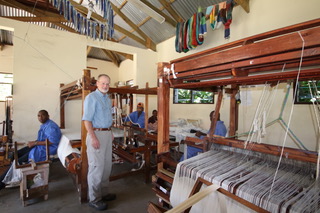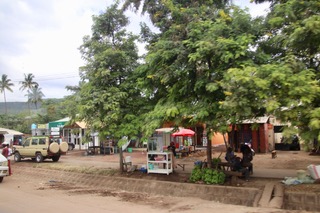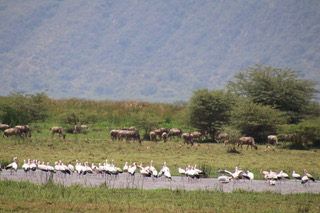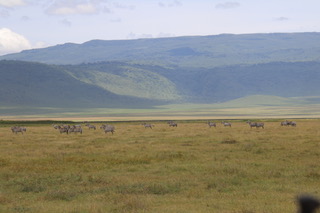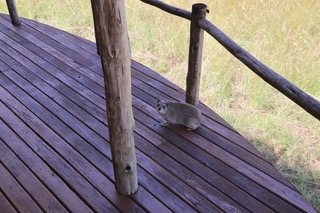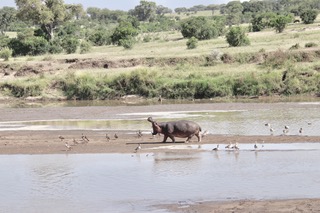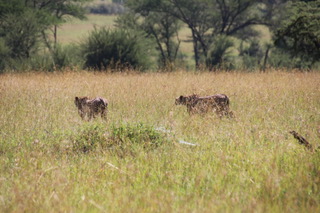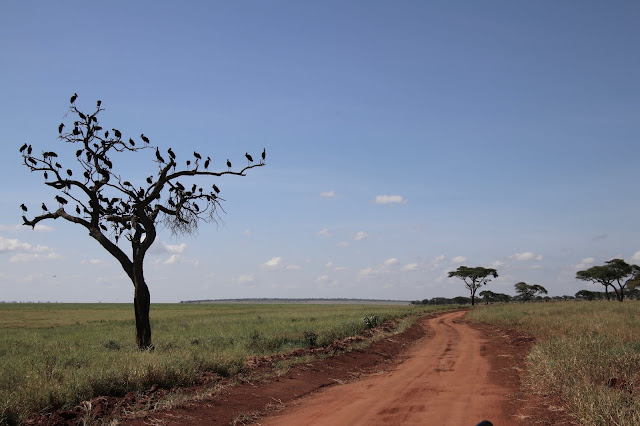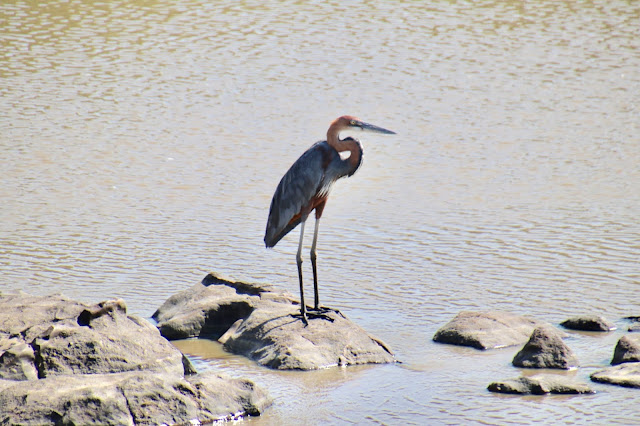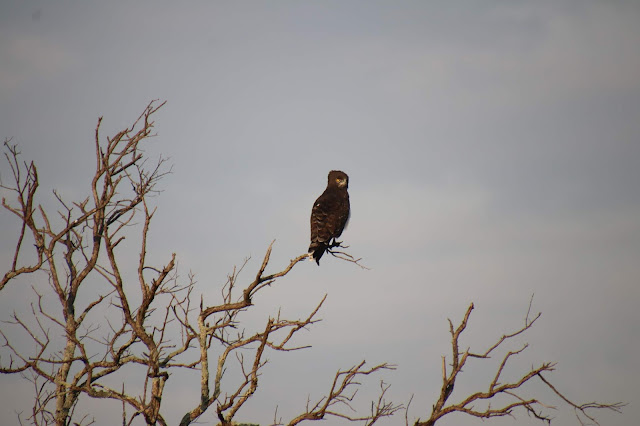We flew 14 hours nonstop from New York to Doha, Qatar on Qatar Airways. We spent the night in a very nice airside transit hotel (it even had a golf simulator!) in this incredible airport.
Believe it or not, this is the main floor of the Qatar Airways business class lounge, we had dinner and breakfast here, in a second floor dining area that overlooks this huge space.
Day Two: February 16. The next day, after another 6 1/2 hour Qatar flight, we landed at the dramatically-smaller Kilimanjaro Airport in northeastern Tanzania, where our local representative Victoria met and shepherded us through immigration. A smooth trip, but 20+ hours aloft is more than enough!
On the 1 1/2-hour drive from the airport to our first lodging, we encountered this young Masai shepherd boy tending his flock of goats that crossed the road just in front of us. The Masai are not the largest, but are the best known and most prominent among more than 120 indigenous groups that maintain their tribal identity and traditions in Tanzania and northward into Kenya. Generally speaking, each group has its own language as well as Swahili, which is spoken throughout East Africa. The Tanzanian government is extending mandatory public education to these groups, which adds English; this youngster spoke just enough English to communicate with us. Although he really wanted a "biscuit" (cookie), he was happy enough to accept a dollar for allowing us to take his photo. This is by no means the last Masai encounter of our trip ... there's much more to come ....
As we progressed slowly along the "highway" (the speed limit is about 30 MPH and there are frequent speed bumps), we passed small villages ...
... and larger markets as we got closer and into Arusha, the regional hub and "Gateway to the Serengeti" that has about 200,000 residents.
Finally, we reached our home for the first two nights -- Legendary Lodge -- in an area of coffee plantations on the outskirts of Arusha. Itself a former coffee plantation, Legendary Lodge has a central manor house surrounded by maybe eight or so cottages like this one we stayed in.
As you can see, we weren't exactly roughing it at this stage of the trip! It's a beautiful, serene place with great food and exceptional service. And ...
... there were Kirk's Dikdiks frolicking right in front of our cottage each morning and evening ... our first glimpse of African wildlife!!
Day 3: February 17. On our first full day, our local host Victoria took us on a quick "city tour" and to see a couple of highlights in Arusha. Shanga is a nonprofit that employs physically- and intellectually-disabled adults in small artistic and manufacturing activities ... many of which involve recycled materials. There are currently 65 such employees, who are enabled through their Shanga employment to live independently and sustain themselves (and, in some cases, their families). This is a critical initiative in a country that lacks any form of public social supports, and it is very inspiring to meet the employees as they work ... they are very proud of what they are accomplishing and very friendly and welcoming to visitors. This is the weaving shop where they dye their own yarns with natural dyes and weave all manner of textiles.
These colorful Tinga Tinga paintings can be personalized and otherwise made-to-order.
With help from a translator, this gentleman is showing Pamela how to quickly scoop beads out of a tray for stringing with a needle. He's a master, and she got pretty good at it by following his tutelage!
In this area, the employees recycle crushed glass into all manner of pitchers, flasks and glassware. Virtually all the many safari camps across the Serengeti use Shanga glassware exclusively.
Finally, in this area employees fold old newspapers into very well-constructed and useful shopping bags with twine handles ... our translator is holding a completed one up. This useful initiative supports a major ongoing effort across the East African nations to stop using plastic bags ... they have actually been outlawed. Interestingly, a number of people we met told us that Rwanda is a national leader in this initiative, and that one notices how "spotless" Rwanda is as soon as one crosses the border.
From Shanga, we drove a short distance to the Cultural Heritage Center ... basically the largest African arts and crafts store you could imagine. No humble place, DHL has an office onsite to ship whatever you buy to wherever home is. If you've got the money and it will fit in an airplane, they'll ship it! We bought a couple (not a pair) of drums that are on the way.
The largest art gallery in Africa is located next to the Cultural Heritage Center. This is Pamela with our local host Victoria on the walkway that runs between them. The gallery has at least seven floors jam-packed with all manner of African art and art objects ... many hundreds of years old. We leave it to sophisticates to assess the quality of the collection, but to us it was quite amazing and overwhelming. All in all, a very interesting half-day or so in a place we'd never heard of, as we rested and adjusted to the time difference before heading off into the bush!
Day 4: February 18. After an early breakfast we took a 12-passenger, single-engine Cessna Grand Caravan from the nearby Arusha airport west into the bush. We would have three more trips on such aircraft during our safari.
After about 25 minutes, we landed on the dirt strip at Kuro, near Tarangire National Park. It's not a busy place. You see Paul in "baggage claim" chatting with our guide from Chem Chem safari camp, Baraka. After Pamela emerged from the remarkably clean washroom, we climbed into the open safari vehicle and set off on a 6-7 hour game drive toward Chem Chem. We would not see a paved road for the next 12 days. Note the bleached animal skulls at the edge of the airstrip ... every bush airstrip we used was similarly decorated ... not sure what that means!
For the first hour or two, we saw beautiful plains and grasslands like these, but little or no wildlife.
That abruptly changed when we encountered a herd of 400-500 African buffalo slowly crossing the road in front of us.
As we grew closer, they kept crossing but started to take notice of us.
As we slowly passed through them, they edged away to their safe distance, but focused on us intently. They just don't look very friendly, do they!
Not long after, we almost drove right past this lion without noticing her ...
Once we did spot her, as is typical she allowed our vehicle to come right alongside with no evidence of concern. Such females are the primary hunters, and they hunt primarily at night and rest in the shade by day.
A short while later, we had our first encounter with a Vervet Monkey ... the first of many ...
Then we encountered a "bachelor herd" of young, male impala ... what beautiful horns!
In the distance we saw our first giraffe ... with many more to come.
Tarangire National Park is known for its elephants, and they did not disappoint. When this small group of elephants approached the road from the right ...
... we were delighted to see the baby bringing up the rear as they crossed the road in front of us!
We stopped for a picnic lunch overlooking a broad expanse of Tarangire, with elephants, giraffes and all manner of wildlife visible below ...
... including these elephants at a water hole.
They may be hard to spot, but these two trees are loaded with a couple dozen Olive Baboons.
As we neared the camp, a radio call directed us to these two lions lounging in the shade.
This is a good-size harem of female impala. The alpha male is somewhere nearby, and note the baby on the left.
Just outside the camp itself we met the local zebras and warthogs ...
... and had a close encounter with a resident giraffe!
Our tent at Chem Chem, with an outdoor lounge platform on the left and an outdoor shower in the rock enclosure on the right. Like all safari camps, there are no fences or other separation from the animals ... when it is dark, you must be escorted to and from your tent, usually by a suitably-armed Masai warrior. This tent is permanent, with a hot shower and flush toilet (things we came to value dearly!).
Day 5: February 19. About half an hour before sunrise on our first morning at Chem Chem, a couple dozen Vervet Monkeys decided to stage the Monkey Olympics on our tent. They jumped, climbed, ran, chased and generally amused themselves ... it was hysterical! There are four in this picture ... three in the tree and one on the tent flap, but they were everywhere ...
... including this one who watched Paul from only a few feet away when he finally had to go outside to take a shower.
The food at Chem Chem was sophisticated and very well-prepared ... as it was at all of the safari camps ...
... and whether anyone else was in the lounge area at the time, you never felt truly alone!
After breakfast, we visited two local schools ... one that Chem Chem has supported for several years, and another that Chem Chem is beginning to support as well.
In the teachers' room, we could see the lesson plans for the current instruction period outlined on the board in Swahili.
Our guide, Baraka, is a "Modern Maasai" from one of the local villages. Like most of the younger guides, he is a graduate of the African College of Wildlife Management and absolutely expert in his profession as a guide. He's also terrific with the children, using pens, pencils, notebooks and similar school supplies as prizes to get the students to tell us their name and age, and ask us questions in English. As you can see, there was a lot of energy and enthusiasm in this classroom!
We also saw several children demonstrate good math skills, solving problems at the blackboard.
Outside on a lovely day, a teacher graded and handed back student workbooks. Tanzania's government is making a major push to make education universal and improve its quality as the key to improving living standards, but like other developing nations struggles to find the resources to match its ambition. We are grateful to be able to support Chem Chem's new relationship with the 400-student Vilima Vitatu Primary School, through renovation of the school building, teachers' rooms and classrooms, new student desks and other support.
After the school visits, we had an opportunity to visit with Choroko, the leader of approximately 4,000 "Traditional Maasai" who live in the area surrounding Chem Chem. The center of a Maasai family compound is the boma, a circular area in which the family's cattle and goats are protected at night from predators by an impenetrable screen of extremely thorny acacia branches or even logs and limbs, as here.
In this photo, Choroko and his four wives (and Pamela) are to Paul's left, and our Chem Chem Traditional Maasai guide, Saruni, is to his right. With Baraka as translator, Choroko described a number of aspects of the Maasai traditional way of life. He explained that Maasai men do not get to choose their wives. Their parents choose the first wife; the first wife chooses the second wife; the second chooses the third, and so on. So, the wives choose their friends, and it appears they help each other doing essentially all the hard work (including building the houses!) while the Maasai men tend the herds and protect against predators. Choroko said he has 22 children with his four wives "so far."
We were invited inside the main home inhabited by Choroko, his wives and their children under the age of 7. At 7, each child is required to move into his or her own small house elsewhere in the family compound. Choroko said this main home took 22 wives from the community 14 days working together to construct.
 The construction involves a frame of wooden poles, plastered over with a mixture of earth from termite mounds, cow dung and cow urine. When this hardens and dries, it has no smell, is waterproof, and is effective in repelling insects up to and including scorpions, and snakes. Inside, the house was divided into four rooms, including a public area for meetings of the local Maasai leaders and sleeping areas for the wives and small children.
The construction involves a frame of wooden poles, plastered over with a mixture of earth from termite mounds, cow dung and cow urine. When this hardens and dries, it has no smell, is waterproof, and is effective in repelling insects up to and including scorpions, and snakes. Inside, the house was divided into four rooms, including a public area for meetings of the local Maasai leaders and sleeping areas for the wives and small children.In the public area, the men stay on the far side of this railing and women stay on the other side. Choroko said this is for the women's safety, as fighting occasionally breaks out during discussions among the men (notwithstanding the heart carved in the wall above my head!). In our discussions, Choroko indicated that the government basically defers to him and other Traditional Maasai leaders to adjudicate disputes and address misconduct within the community, rather than involving the police or court system. Although young Maasai may choose to be "Modern Maasai" and live in a modern manner, the number of Traditional Maasai does not seem to be declining and Choroko expressed confidence that Traditional Maasai life would continue without significant threat from modernization and development. The Chem Chem manager told us Choroko would be the "smilingest man" we would likely ever meet, and we certainly had a warm, friendly and fascinating visit and open discussion with people living happily in a manner we can hardly comprehend.
In the late afternoon, Saruni led us on a "bushwalk," showing us many animal tracks and how the Maasai use particular plants for medicinal and utilitarian purposes ... like toilet paper, sandpaper and toothbrushes. Eventually, we reached our game drive truck parked out in the bush, and climbed to go off for a "sundowner" ... not really knowing what that was. As we drove across a virtually-deserted plain toward the shore of Lake Manyara, we saw a vehicle far away by the shore and remarked how nice it was that somebody else was out to see what promised to be a beautiful sundown over the lake. Only as we kept heading for the vehicle did we realize it was for us! They actually brought tables, chairs, snacks and a portable bar all the way out there so we coud sip drinks and watch the sun go down ... unbelievable!
In front of us, a flock of pelicans and other waterbirds stood in Lake Manyara. The hills on the far shore are the eastern slopes of East Africa's Great Rift Valley, where a crack in the African tectonic plate is slowly widening.
During our bush walk, Saruni had told us that dried zebra poo is prized for starting fires, because the zebra's very poor digestive system leaves lots of combustible organic material. He put it to the test by using the traditional Maasai stick-friction technique to start a fire.
After no more than a minute of work ... voila! A blazing fire!
After the sunset, we drove back to camp solely by the light of a full and large moon (to keep insects from being attracted by our headlights), for a dinner on the lawn surrounded by a field of small lamps, and the end to another amazing day.
Day 6: February 20. We took an early morning bush walk with Baraka and Saruni to this 2000-year-old Baobab tree.
Incredibly, although it was completely healthy, the tree was almost-completely hollow inside. You could live in it, and any number of bats and birds do ... it's hollow all the way up to where the trunk splits into two sections!
A delightful bush breakfast ...
... right under the amazing tree.
After breakfast, we took an extremely fruitful game drive meandering back toward camp. Here's a giraffe drinking ...
... a warthog family out for a morning stroll ...
... two juvenile male impalas sparring ...
... lions yawning ...
... ostriches on the plain ...
... and thousands of flamingoes on Lake Manyara.
Kudus are extremely shy, but as we rounded a curve in the road, this one stood proudly and calmly on a termite mound, posing while we got this great photo.
A lone buffalo may be less intimidating than a herd, but he doesn't look any more friendly.
Giraffes seemed to appear all over.
And the climax was 13 elephants crossing in front of us, including these babies. After lunch in camp, we had a quiet afternoon of hot showers (and a massage for Paul) followed by a rooftop dinner and early to bed on our last night in Chem Chem.
Day 7: February 21. Before our final breakfast at Chem Chem, we had one last visitor to our tent ... he looks sad to see us go, doesn't he?
Breakfast entertainment included a really large troop of baboons crossing the field in front of the camp. We heard lions nearby during the night, and the staff thought the baboons were moving away from where the lions were.
After breakfast, our guide for the next five days, Felix, picked us up and we headed off (in a blessedly enclosed safari truck!) toward an actual paved "highway" that led to Lake Manyara National Park.
On this "gateway to the Serengeti," we drove through a lot of villages with a lot of trading and selling to safari tourists going on ... very active and pretty prosperous.
Just before the entrance to the National Park, we encountered a large troop of baboons by the side of the road. In addition to this very cute mother and baby, we saw baby baboons playing with baby Vervet Monkeys, which Felix thought was very unusual.
A moment of self-reflection, perhaps?
It's a very good thing we had an enclosable vehicle, because the baboons got very curious!
Once in the Park, we got our first view of Common Wildebeests in the meadow behind these White Storks ... a foreshadowing of things to come on the Serengeti.
We were close behind another vehicle, and had to backup a few feet so that this fellow could follow his small herd across the road ... our closest approach to an elephant on the entire trip. He was not perturbed.
Soon we started seeing mixed groups of zebras and wildebeests, with newborn wildebeests ... this would also become commonplace toward and on the Serengeti.
Before leaving the Park to ascend to the rim of Ngorongoro Crater, we saw this ancient wild native mahogany tree ... not endangered, but pretty unusual to see. This tree can live up to 350 years, and this one certainly didn't look like a spring chicken!
About 1,900 feet of elevation above Lake Manyara, we reached the rim of Ngorongoro Crater, like the Serengeti itself a UNESCO World Heritage Site.
Ngorongoro Crater was formed when an enormous volcano collapsed after a major eruption about 2.5 million years ago. The floor of the crater is roughly 12 miles in diameter, occupying 102 square miles, and the crater walls rise about 2,000 feet to heights of 7,500-9,000 feet. The entire crater, and much surrounding land, is a protected nature reserve. After taking photos at this scenic overlook, we headed along the rim to check-in for two nights at the Ngorongoro Crater Lodge.
Our cottage was one of six in an area of the Lodge called Tree Camp, and it was aptly named.
Built in a circular style reminiscent of a Maasai house, the interior of our cottage was amazing and almost-impossible to describe. We had a soaking tub with a picture window overlooking the Crater ...

... as did the balcony directly in front of the bed. Paul watched monkeys jumping around in the trees.
We had cocktails and meals in the Tree Camp lounge and dining room, which was down a flight of stairs about 50 feet below our cottage. This is the cocktail area, with a large fireplace on the left.
This view is from the cocktail area into the dining room, past a huge tree that the entire structure is literally built around. We have never seen anything like it.
And the view of the Crater from the deck is to die for ... after a dinner that included a live musical performance by a group of employees (yes, we bought their CD!), we were escorted back to our cottage to find a roaring fire in the fireplace ... something we never expected in East Africa!
Day 8: February 22. After descending 2,000 feet to the bottom of the Crater on a very narrow and rocky one-way road, we spent the entire day among the incredibly diverse wildlife it shelters. Here are a number of Thomson's Gazelles ...
... and a troop of Vervet Monkeys.
These birds were agitated by a predator on the ground just below them, and continuously hovered and flapped their wings to try to drive it away. It was likely a snake, or perhaps a mongoose.
Wildebeests move in and out of the Crater at will, and we found large herds of them present.
This baby wildebeest may be no more than a day or two old. Babies must be able to stand immediately and move at the same speed as their mother within 15 minutes of birth, in order to have a chance of survival. Even so, 40% do not survive their first year due to predators and the rigors of the Great Migration.
This little zebra family is grazing in front of a waterhole that holds a number of Hippopotamuses (or Hippopotami, if you prefer). Our guide Felix considers it a great mystery as to how there are Hippos living in the Crater, as it hardly seems possible they would have migrated up and over the Crater rim and back down to its floor from the nearest known population in Lake Manyara. He has a point ... they don't like to be out of the water for long, and are not known to migrate. Another thing to keep us all up at night ...
Here's a Golden Jackal.
These zebra stopped suddenly on their way to a waterhole, and were all focused intently to the left ...
... at this pride of 6 female lions that approached the other side of the waterhole and settled down in the grass at its edge. After a long stare down, a few of the zebra moved way to the right to get to the far end of the waterhole, while the rest of the herd kept their eyes on the lions. The lions are ambush hunters, and the zebra clearly know what their safe distance needs to be from any known lions.
Estimates of the Crater's Black Rhino population range from 30 to 40, spread over its 100+ square miles, so we were thrilled to see this one. A close approach is not an option with these shy and potentially nasty beasts.
The Serval is a small and very shy cat, not often seen ... we were very lucky to get this photo during a single, sudden and fleeting encounter.
A shallow, alkaline lake in the Crater hosts a large population of flamingoes and other waterbirds.
The Crater has Side-Striped Jackals as well as Golden Jackals.
Lion love drew lots of onlookers ... no surprise, of course. When lions mate, they may do so as frequently as every 15 minutes for several days.
Jackals aren't the only predator/scavengers in the Crater. Here's a Spotted Hyaena.
After a full day in the Crater, we were happy to make it up to the rim on a much smoother one-way exit road, and back to the Lodge to watch the sunset with drinks in hand!
Day 9: February 23. We said goodbye to the Crater Lodge, and headed off toward the South Serengeti. Our first stop was the Olduvai (actually Oldupai) Gorge, where anthropologists Richard and Mary Leakey discovered the oldest known ancestors of modern humans in the 1950s and 60s.
A large covered amphitheater looks out over the Gorge, and an anthropologist gives visitors an introductory overview of the Gorge's geological history and the significant discoveries made there. Excavations continue to this day.
The museum has excellent and detailed displays presenting current understanding of the evolutionary origins of mankind, including replicas of the key fossil remains. This is the replica of the most famous fossil skull found in the Gorge -- Zinjanthropus boisei (later reclassified as Paranthropus boisei). The Leakey's discovered this fossil skull in 1959, and it has been dated at 1.84 million years old. The original is in the National Museum in Tanzania's capital, Dar es Salaam.
From Oldupai Gorge, we carried on across trackless plains to a phenomenon called the Shifting Sands. See the low mound of dark sand beyond our safari truck on the right side of the photo just below the horizon? In 2015, that pile of sand was where the marker is in the foreground of the photo. There are annual markers going back to 2010 charting the progress of this pile of sand as it is moved by the generally prevailing winds.
As we were exploring the Shifting Sands, these three Maasai shepherd boys came to explore us ... in the midst of a desolate plain with nothing and no one else within miles in every direction. Note the spears the two older brothers carry. They were very friendly, and were happy to accept $1 each to be photographed and water. They said they could convert the dollars to Tanzanian shillings at the Oldupai Museum ... about 6 miles away! Felix conducted the negotiations and made sure each boy got his own equal share, so that the youngest didn't lose out to his older brothers.
This is the leeward side of the Shifting Sands. According to websites found on Google, these particular volcanic sands have a high iron content and are strongly magnetized, which would perhaps explain why they stay together rather than disperse in the prevailing wind. One site reports an estimate that this dune has been moving across the savannah for up to 3 million years.
Between Shifting Sands and our next camp, the main wildlife we saw were giraffes. Here are two males engaging in a gentle form of what Felix said is actually fighting with their necks. It was all in very slow motion.
And here we came across 7 giraffes, all browsing among low shrubs. This is unusual, as they generally prefer using their full height to reach the leaves of acacia trees.
After this very interesting day of anthropology and scientific oddity, we arrived at our home for the next 3 nights ... one of 8 tents at the Serengeti Safari Camp No. 1. This camp actually moves 4 times a year, following the Great Migration north across the Serengeti to its climax at the Mara River crossings on the Kenyan border. Everything is completely portable, as the sites are not predetermined but vary based on the behavior of the wildebeest herds.
In many respects, this camp was just as comfortable as the other places we stayed.
That said, we had a chemical toilet, the hot water at the sink was from a thermos, and the shower was a "bucket shower" ... when you wanted to take a shower, a member of the staff would bring a large bucket of heated water and dump it into a contraption outside the tent, which you could in theory then release and control through the shower head with a toggle valve. These are also called "talking showers," because you have to maintain a dialogue with the guy outside to make sure you get enough water. It makes for great stories, but we don't think it will ever catch on as a preferred alternative to plumbing!
The dining and lounge tent was the centerpiece of this camp. They also had a very nice fire pit outside, around which we gathered each evening for sundowners before dinner.
The tent had dining tables at one end, a bar in the middle, and a lounge/library area at the far end, with a solar-powered charging station for cameras and personal electronics, and perhaps the world's smallest Wi-Fi hot spot ... about a 15-foot circle ... but it worked! Not bad for a place miles and miles from the nearest paved road. And the food was really good!
Day 10: February 24. The wildebeests weren't the only animals having babies in the South Serengeti, as this Thomson's Gazelle nursing hers evidences.
On our morning game drive, we spotted our first Cheetah.
She was beautiful, and completely relaxed as we came closer.
She was much more interested in the nearby wildebeests than in us, but she would need to get the drop on a baby or an isolated, maybe old or ailing one in order to bring it down. She can outrun anything, but only for short distances.
After seeing another cheetah, we stopped for breakfast on the plains and contemplated the extraordinary view of the wildebeest continuing to gather for their Great Migration following the rains north.
These vultures stripping a zebra carcass reminded us about the raw "circle of life" going on all around us.
Elands are the largest species of antelope, and are very shy ... we were lucky to get this clear photo.
The evening game drive brought our first spotting of a leopard. The tip was seeing the tail hanging down from the tree limb ... this first photo is with the maximum setting on our telephoto lens ... we were about 500 yards away.
Over about 45 minutes, Felix slowly maneuvered our truck closer and closer. Fortunately, as this big yawn indicates, we never spooked the leopard.
Eventually, the leopard did take some mild interest in us ...
... and after awhile, as sunset approached, decided to move -- in search of dinner, maybe?
What a beautiful animal!
Day 11: February 25. We started our morning game drive along the shore of a lake with a number of hippos.
Skeletons and carcasses along the shore are reminders of how dangerous waterholes can be!
This lion in a tree had her eye on a lot more than us ...
... as a herd of wildebeest slowly proceeded through an open area in the grasslands close by.
A beautiful animal, Felix was pretty sure she had an accomplice in another tree on the far side of the wildebeest column.
Shortly, she came down the tree and slipped into the brush toward the wildebeests. However, we noticed that several wildebeest mothers with their babies got nervous and decided to turn around and go back the way they had come, rather than follow the herd through the open area.
That may have been a very prudent decision, because we did indeed find the second lion in a tree on the other flank of the wildebeests. It might have been a perfect ambush ...
A bit later, we saw our first Mountain Reedbucks ... very handsome!
Of the many giraffes we saw, only a couple were sitting down like this one.
Later in the day, we encountered these two adult female lions with a cub.
Hard to be much cuter than this!
The lionesses wanted to slip through the bush and try their luck with a small group of wildebeests nearby. But the cub couldn't stay quiet and tipped off the potential prey. Oh well, time for a cuddle!
Day 12: February 26. At breakfast on our last morning in the South Serengeti, this 4-foot tall stork maintained a vigil 50 feet from the dining tent, hoping for a scrap. Huge bird!
As we drove toward the airstrip, we saw lots of wildebeest and zebras on the move.
Soon, we reached the Ndutu Airstrip, said goodbye to Felix ...
... and boarded our Coastal Air flight ...
... to Seronera Airstrip, gateway to the central Serengeti and by far the largest and busiest airfield we saw in the bush. Here our new guide Moinga picked us up in another completely open game truck, and we set off toward our new camp at Namiri Plains.
The first we noticed was that the grass in the Central Serengeti was much taller and thicker than in the South. This helps predators sneak up on their prey, but also helps smaller prey escape detection.
The Central Serengeti is also distinctive in the number of rocky volcanic outcroppings that rise directly out of otherwise extremely flat and open plains. Predators can often be found on or around these rock outcroppings, seeking the high ground to watch for prey, and competing predators.
Not far from the airport, we encountered a ring of safari vehicles almost surrounding this big male lion just off a busy road. He was with a female, and yes, they mated while we were there. No, we're not showing those photos again ... once is enough.
... a Coke's Hartebeest ...
... a Topi ...
... and a Grant's Gazelle.
We spotted a female lion's head under a tree about 100 yards to our right. When we drove over to investigate, we found a pride of 13 adult females! They were so relaxed, the one at the upper right couldn't even be bothered to rollover from her back to check us out. If they had wanted to, they could have eaten the three of us in our completely open truck in no time, but they had no interest in doing so.
Just before reaching camp, we passed by these adult male and female ostriches. The camp manager told us she thinks the mating dance of ostriches is one of the most beautiful things she has seen in nature.
Namiri Plains is a permanent camp, and we actually had very good Wi-Fi in our tent.
More importantly, we had real plumbing and plenty of hot water ... all solar-powered. By June, this camp will be replaced by a new one nearby with a swimming pool and spa ... not too shabby!
Day 13: February 27. Sunrise over the Central Serengeti ... our morning game drives started at 6:30 a.m., before sunrise, so we enjoyed a lot of these beautiful scenes!
Not far from camp, we came upon a group of a dozen or so elephants. Moinga said they seemed a bit anxious, possibly sensing a predator nearby, and this mature bull certainly kept an eye on us.
Early on, we came upon these two cheetahs, in what would be a very big cheetah day.
Built for speed more than power, cheetah look more "cat-like" than the larger feline predators.
As the day before, we saw a continuing variety of wildlife ... here, topi and hartebeests ...
... a Spotted Hyaena ...
... Zebras ...
... and an Oribi, a small antelope that is rarely seen.
After we came upon this solitary cheetah resting on the plain, she stretched, yawned, and wandered away to start her day.
A bit later, we encountered two more cheetah resting on the plain. Look how stressed out they are by our approach!
The rock formations are really interesting, and it's hard to believe how precariously some of the rocks are balanced on top of others.
African buffalo roam the entire Serengeti.
We spotted what appeared to be a lion sunning atop the detached rock out on the plain in the left of this photo.
On closer inspection, it turned out to be a mother with two cubs.
They were protecting a fresh wildebeest kill (bottom left corner of the rock), probably from the night before.
As we looked closely at the larger rock formation about 50 yards away, we saw another adult female in deep grass in front of a collection of rocks. Then, safely up among them, we saw two more cubs ... who were very curious to see us. All quite amazing!
We didn't think anything could equal the lion nursery, but not long after we actually saw a group of 5 cheetah traveling together on the plain. Moinga said he had never seen more than 4 together, and this was very special. They were shy of our vehicle and in a place where we could not really approach, but it was memorable to see them even at this considerable distance.
On the way back to camp, we passed this elephant drinking from a small stream.
After a huge day of predators, it was almost comic relief to come upon this leopard tortoise.
Moinga showed us how to count the rings in the tortoise's shell to determine its age ... an interesting end to another great day on the Serengeti.
Day 14: February 28. After breakfast, we bid adieu to Namiri Plains, and headed back to Seronera aistrip to catch a flight north to Kogatende, near the Kenyan border. These four adult lionesses were waiting on the roadside to say goodbye!
Kogatende didn't even have a building, just the dirt strip and a gravel parking area. Note the Park rule "Do not cross Kenyan border" ... more on that later ....
The grasslands near the airstrip were quite lush and high. We saw Banded Mongooses, a Single-Striped Grass Mouse and a Scrub Hare, but our photographs of them are unremarkable. From this photo, you can see how effectively the lion's coloration camouflages her in these taller grasses.
The Lamai Serengeti camp, our final safari home, is built into a very large rocky escarpment that looks over seemingly endless miles of the North Serengeti. Our cottage on the camp's lower level ...
... had a panoramic view from the deck. You could literally sit on the deck with binoculars and see all manner of wildlife for miles.
As Paul did so, several times he found himself sharing the deck with one or two very friendly Rock Hyrax. These little critters were everywhere in the rock outcroppings around the camp, and would slowly creep closer and closer on the deck until settling down only 2 or 3 feet away and going to sleep. Our guide Emmanuel explained that they get a great view of any threat from the deck, and are protected by its roof from the eagles and falcons that are their greatest predator. They had little, if any, fear of humans. Very cute!
Lamai Serengeti is also a permanent camp. Our cottage had a very comfortable master bedroom ...
... and a huge bathroom with real plumbing, plenty of solar-powered hot water, and even a second bedroom in the back. Wi-Fi was limited to a small building up near the dining and lounge area, but otherwise this place was great.
After settling in, we went on a late afternoon game drive. There were more rocky outcroppings here than in the Central Serengeti, and we quickly spied these two Klipspringers keeping watch from a high vantage point.
This Defassa Waterbuck was a new sight for us.
This photo shows how nimbly the Klipspringers can scramble up the rocks. Note also the Rock Hyrax already on top.
The climax of this late-day drive was finding this leopard relaxing on a rock in this stream bed.
As we got close, she stretched, yawned, groomed herself and dozed. She wasn't in any hurry to start her nocturnal rounds by the time we had to leave to get back to camp by sundown. A great last find for the day!
Day 15: March 1. Our primary objective today was to reach one of the crossing points on the Mara River where the Great Migration of 1.2 million wildebeests reaches its annual climax. As we descended to the plain from camp, the early morning view was awesome. The Northern Serengeti is so remote, and so few visitors come during this "offseason," that we only saw one other safari truck during our 2 1/2 days in the bush here ... we were entirely alone almost the entire time.
We enjoyed playing a bit of "peekabo" with this giraffe.
After a considerable drive, we reached the area around Crossing Point 7 on the Mara River. The Great Migration reaches these crossing points when the river is in flood, and thousands of wildebeest die from trampling or other injuries in trying to navigate the steep slopes into or up out of the raging currents, drowning in too-deep water ...
... being eaten by the Nile crocodiles who (along with the great feline predators) congregate at the crossing points for an easy meal ...
... or cross paths with the incredible number of Hippos who call the deeper pools in the river home. We had breakfast overlooking a stretch of the river with more than 200 hippos. Hippos don't eat wildebeest, but they are ornery and can crush a wildebeest with one bite if annoyed.
Although most of the hippos were in the water, many were sunning themselves on the bank. Note the baby hippos staying close to their mothers.
These are enormous animals! And like the buffalo and rhino, they just don't look or act in any way friendly.
This one is just yawning, but you can see he's got a really big jaw and some serious teeth!
We saw quite a bit of bellowing, splashing, thrashing and throwing water around among several of the big males in the water. Emmanuel told us this acting-out is usually about competition for females or protecting territory ... no surprise there.
The hippos were an absolute highlight of our trip, but there was still plenty to see as we left them and made our way back toward camp. Here's a solitary Bohor Reedbuck relaxing ...
... Topis and Zebras on the plain ...
... Cheetahs on the prowl ...
... and an elephant herd.
As with many of the animals, it's always moving to see how close the babies stay to their mother.
Near camp, we got a good look at several Dwarf Mongooses ...
... and a final view of some ostriches ...
... before another spectacular sundown on the North Serengeti!
Day 16: March 2. Our last day in the bush started with yet another surprise. Just before sunrise, less than 30 minutes from camp, we saw this mother Cheetah and her cub right out in the open lounging atop a termite mound, less than 50 yards to the right of our driving track. Our guide Emmanuel said this was a highly unusual place for them to be.
As we watched, they dozed, yawned and stretched. Finally, as the sun broke the horizon they slowly wandered off to start their day.
Emmanuel called this period just after the sun breaks the horizon the "golden Time," and it's easy to see why. These Steenboks literally jumped along through the tall grass, in order to see where they were going and in hopes of seeing any predators in time to avoid a bad end.
As we left the tall grass for the broad plain leading to and across the Kenyan border, the impala were frolicking, too.
The plain was filled with different species as far as one could see. Here ... buffalo ...
... elephants, with topis and buffalo beyond ...
... and a very cute baby zebra!
In the middle of all this, we came across two cheetah brothers who were just starting to wake up.
As they came to life, we watched them affectionately groom each other for several minutes ... quite remarkable!
Finally, they, too, headed off to find some breakfast.
Presently, we reached the Kenyan border. (Oops ... I think we took this photo from the wrong side!). Anyway ... no wall here, just a marker on the ground every 500 yards or so ... and the animals going back and forth everywhere, oblivious to it all.
All the animals kept their distance from a single Spotted Hyaena trotting around.
This male lion was apparently waiting for the ladies of the pride to bring something home for dinner (and otherwise attend to his needs).
We even saw a small group of wildebeests who are resident here year-round. One wonders whether they join the last stage of the Great Migration, with all of its perils, or just find enough to eat on this plain and conclude it's safer for them and their babies. Count them the lucky ones, in our book!
Topis were also very plentiful on this amazing plain, as we completed our program of game drives in the Tanzanian bush and Serengeti having seen at least 39 different species of mammals ... more than we could ever have imagined!
Day 17: March 3. On the morning of our departure day, several Vervet Monkeys decided to haunt our last breakfast in hope of picking up some bread from the table. But we safeguarded everything until the waiter could take away the scraps. Then starting with a half-hour ride back to Kogatende, we flew to Arusha, transited to Kilimanjaro, flew 6 1/2 hours back to Doha and 14 more from Doha to JFK ... happy to get home safely and on time after another wonderful adventure!
The Birds of East Africa. There are almost 1000 species of birds recognized as living in Tanzania and the other countries of East Africa. We saw an incredible variety of beautiful and interesting birds, and photographed many ... far beyond our ability to identify and catalogue. So here, without elaboration, are the best photos we were able to capture of birds and their very interesting nests.
***THE END***









